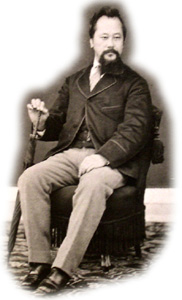|
1 Joseph Heco Story

{ JOSEPH HECO, THE ACCIDENTAL WORLD TRAVELER }
The 14th Annual Honolulu Festival takes its theme from the story of Joseph Heco, the first Japanese to become an American citizen. June 30, 2008 will be the 150th anniversary of his naturalization. Why is this date significant? To understand, we need to know what Japan was like 150 years ago.
 Japan During the Tokugawa Shogunate Japan During the Tokugawa Shogunate
150 years ago, in 1858, Japa n was still under the Tokugawa Shogunate, and would not be open to foreign trade (other than with the Dutch and the Chinese) for another year. The Tokugawa Shogunate had Japan under lock and key from foreign interaction since 1639. Under this policy called Sakoku, it was illegal for any foreigner or Japanese to enter or leave Japan, on penalty of death. Although Commodore Matthew Calbraith Perry signed the Treaty of Kanagawa with the representatives of Shogun Tokugawa Ieyoshi in 1854, which opened two Japanese ports to American ships, n was still under the Tokugawa Shogunate, and would not be open to foreign trade (other than with the Dutch and the Chinese) for another year. The Tokugawa Shogunate had Japan under lock and key from foreign interaction since 1639. Under this policy called Sakoku, it was illegal for any foreigner or Japanese to enter or leave Japan, on penalty of death. Although Commodore Matthew Calbraith Perry signed the Treaty of Kanagawa with the representatives of Shogun Tokugawa Ieyoshi in 1854, which opened two Japanese ports to American ships,

|
|
it would still be illegal for Japanese to leave their country until the Meiji Restoration in 1868. So how did Joseph Heco become an American citizen in 1858, ten years before it was legal for a Japanese to leave his country?
 A Life-Changing Shipwreck A Life-Changing Shipwreck
Joseph Heco was born in1837 in Harima, a coastal village in what is now Hyogo Prefecture. His childhood name was Hikotaro. He was 13 years old when he took a sightseeing trip  aboard a ship called the Eiriki-maru. The ship was damaged in a violent storm, and it drifted for 52 days. Because of the Sakoku policy, the Japanese ships of the period were not designed for long ocean voyages, and so the Eiriki-maru tossed helplessly in the waves. aboard a ship called the Eiriki-maru. The ship was damaged in a violent storm, and it drifted for 52 days. Because of the Sakoku policy, the Japanese ships of the period were not designed for long ocean voyages, and so the Eiriki-maru tossed helplessly in the waves.
Luckily, the ship had a cargo of rice and other foods, and the crew of eighteen men survived their ordeal long enough to be spotted by the Auckland, an American merchant ship on its way back to San Francisco from trading in Shanghai. The Americans rescued the shipwrecked Japanese and treated them kindly, despite the language gap.

 |
|